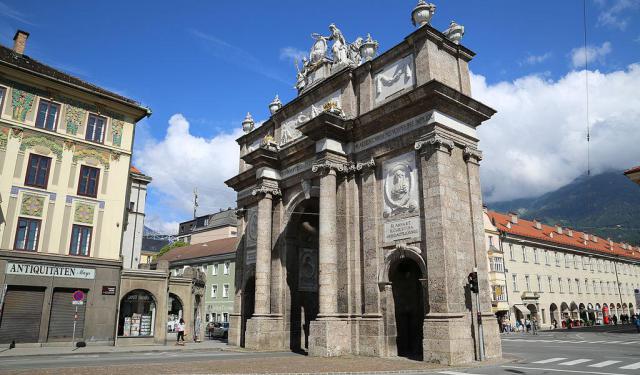
Tiroler Landestheater (Tyrolean State Theatre), Innsbruck
The Tyrolean State Theatre (Tiroler Landestheater) in Innsbruck holds significant cultural and historical importance, situated close to the charming Old Town. It stands amidst prominent landmarks like the Imperial Hofburg, the tranquil Hofgarten, and the academic hub of the SOWI Faculty of the University of Innsbruck, serving as a key venue for the performing arts in the region. Approximately 600 performances are staged each season and around 30 new productions are created.
The theatre consists of a main hall accommodating approximately 800 spectators and a smaller studio theatre in the basement with a capacity of 250, offering a diverse array of performances including plays, operas, operettas, musicals, and dance theatre. Its origins date back to 1629 when architect Christopher Gump the Younger converted a house near the Imperial Hofburg into the Comedihaus, marking the beginning of its theatrical legacy.
In 1654, Christopher Gump constructed a new theatre across the raceway, laying the groundwork for the present Tyrolean State Theatre. Over the years, it underwent renovations and changing identities, including a stint as the Royal Bavarian Court National Theatre during Bavarian occupation in 1805. By 1844, it had fallen into disrepair and was closed.
However, a resurgence of interest in theatre in the 1840s led to the establishment of the present theatre building in 1846 through the efforts of a newly formed theatre company and generous donations. Renamed the Tyrolean State Theatre in 1945, it has undergone significant upgrades to accommodate modern productions, including the addition of a studio theatre in 1959, major reconstruction and expansion of the main theatre in 1961, and subsequent renovations in 1991 and 1992 to create a flexible space theatre.
A significant addition to its infrastructure was a new rehearsal stage in 2003, designed by architect Karl Probst of Munich, enhancing its capability to host ambitious productions. The recent completion of facade renovations and the construction of a new forecourt signify the culmination of its development, ensuring that the Tyrolean State Theatre remains a vibrant platform for the performing arts in Innsbruck.
The theatre consists of a main hall accommodating approximately 800 spectators and a smaller studio theatre in the basement with a capacity of 250, offering a diverse array of performances including plays, operas, operettas, musicals, and dance theatre. Its origins date back to 1629 when architect Christopher Gump the Younger converted a house near the Imperial Hofburg into the Comedihaus, marking the beginning of its theatrical legacy.
In 1654, Christopher Gump constructed a new theatre across the raceway, laying the groundwork for the present Tyrolean State Theatre. Over the years, it underwent renovations and changing identities, including a stint as the Royal Bavarian Court National Theatre during Bavarian occupation in 1805. By 1844, it had fallen into disrepair and was closed.
However, a resurgence of interest in theatre in the 1840s led to the establishment of the present theatre building in 1846 through the efforts of a newly formed theatre company and generous donations. Renamed the Tyrolean State Theatre in 1945, it has undergone significant upgrades to accommodate modern productions, including the addition of a studio theatre in 1959, major reconstruction and expansion of the main theatre in 1961, and subsequent renovations in 1991 and 1992 to create a flexible space theatre.
A significant addition to its infrastructure was a new rehearsal stage in 2003, designed by architect Karl Probst of Munich, enhancing its capability to host ambitious productions. The recent completion of facade renovations and the construction of a new forecourt signify the culmination of its development, ensuring that the Tyrolean State Theatre remains a vibrant platform for the performing arts in Innsbruck.
Want to visit this sight? Check out these Self-Guided Walking Tours in Innsbruck. Alternatively, you can download the mobile app "GPSmyCity: Walks in 1K+ Cities" from Apple App Store or Google Play Store. The app turns your mobile device to a personal tour guide and it works offline, so no data plan is needed when traveling abroad.
Tiroler Landestheater (Tyrolean State Theatre) on Map
Sight Name: Tiroler Landestheater (Tyrolean State Theatre)
Sight Location: Innsbruck, Austria (See walking tours in Innsbruck)
Sight Type: Attraction/Landmark
Sight Location: Innsbruck, Austria (See walking tours in Innsbruck)
Sight Type: Attraction/Landmark
Walking Tours in Innsbruck, Austria
Create Your Own Walk in Innsbruck
Creating your own self-guided walk in Innsbruck is easy and fun. Choose the city attractions that you want to see and a walk route map will be created just for you. You can even set your hotel as the start point of the walk.
Innsbruck's Architectural Jewels
Coveted by empires, republics and ruling dynasties over the centuries, Innsbruck has been a living treasure house of history and culture. Undoubtedly this is one of Europe's most idyllic cities, nestled amid the craggy peaks in the heart of the Austrian Alps. Innsbruck equally scores as an Alpine playground and a showcase for Hapsburg imperial heritage, and is famous for its ancient,... view more
Tour Duration: 1 Hour(s)
Travel Distance: 1.4 Km or 0.9 Miles
Tour Duration: 1 Hour(s)
Travel Distance: 1.4 Km or 0.9 Miles
Innsbruck Introduction Walking Tour
Innsbruck is the capital of Tyrol, Austria. It lies in a broad valley on the river Inn, not far from the Brenner Pass. The name "Innsbruck" means "Bridge over the Inn." In the 4th century Romans established a military outpost there, calling it "Bridge over the Oeni" ("Oeni Pontum" in Latin).
In 1180 the Counts of Andechs took over the town. The Brenner... view more
Tour Duration: 1 Hour(s)
Travel Distance: 1.8 Km or 1.1 Miles
In 1180 the Counts of Andechs took over the town. The Brenner... view more
Tour Duration: 1 Hour(s)
Travel Distance: 1.8 Km or 1.1 Miles


